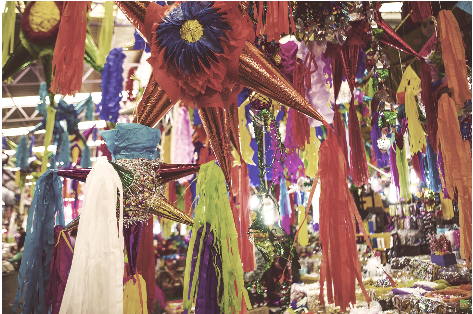Christmas Traditions in Mexico
By: Maria Garcia Manzano, AEIC of The Quill
Photo Credits: Google Images
Mexico is famous for a variety of different celebrations. Perhaps one of the most famous
and recognized around the world are its Day of the Dead celebrations. But as someone who
was born in Mexico can attest, we also have our own unique Christmas traditions.
Traditional Christmas celebrations in Mexico are a mixture of religious traditions and modern
festivities. The result is a truly enchanting and magical holiday season. The Mexican celebration
of Christmas begins each year on December 16th . Long before the standard Christmas Eve.
In this article I will discuss a variety of Christmas traditions that are celebrated in Mexico.
Las Posadas
The first thing you need to understand about Christmas traditions in Mexico is the
tradition of posadas. This translates to mean “inn” in English, and the celebration begins on
December 16th. Each night from the 16th until the 24th, children go from door to door singing
and asking if there’s an open room at the “inn.” This is meant to represent the story of Mary
and Joseph, but modern-day traditions feature a posada party at the end of each night.
Children will be given candy and Christmas oranges.
Nativity Scenes
If you thought the offerings at the Day of the Dead festivals were impressive, then just
wait until you the some of the more elaborate nativity scenes in Mexico. Because the culture is
still quite religious, the Christmas season is rooted in the Christian story of the birth of Baby
Jesus. Therefore, Christmas nativity scenes are important. However, you won’t find Baby Jesus
inside of the manger until the 24th.
Piñatas
Head to any posada party and you’ll undoubtedly find a piñata hanging from the
ceilings. These are popular additions to nearly every Mexican festivity, and the tradition carries
over into Christmas as well. At Christmas time, however, the piñatas have seven different spikes
around them to represent the seven deadly sins.
Ponche and Rompope
Ponche is pretty much the Mexican equivalent of the kind of mulled wine you’ll find at
European Christmas markets. The warm Christmas punch is made with fruit. And, Rompope is
the equivalent of egg nog. You’ll pretty much always find it spiced to perfection and full of
really strong rum. So, its creamy, filling, and quite alcoholic, usually.
Día de Los Reyes
Similar to Spain and other parts of Latin America, certain families in Mexico celebrate
the Three Kings Day, which falls on January 6th each year. While Santa still visits children on
Christmas Eve, it’s not uncommon for the Three Kings to pay a visit the evening before the
Three Kings Day and leave some candy or small gifts. Children will typically leave their shoes out
with their gift wishes and wait for the three kings to read them.
Rosca de Reyes
Because the Three Kings Day is one of the most popular Christmas traditions in Mexico,
you better bet that there’s a cake to accompany the festivities. On this special day, families
gather around to enjoy something called a Rosca de Reyes. The oval-shaped bread is covered in
fruits and, hidden inside, you’ll find a baby figurine. Whoever gets the small plastic baby in their
slice has to throw a tamale party on February 2nd.
Candelaria’s Day
February 2nd might be the day of the coveted tamale party. But it also marks the end of
the Mexican Christmas season. The day itself is called La Candelaria, or Candlemas, and it’s
marked by lots of crazy parties and festivities to end the wonderful holiday season.

